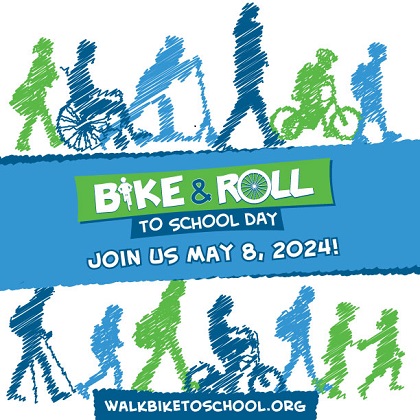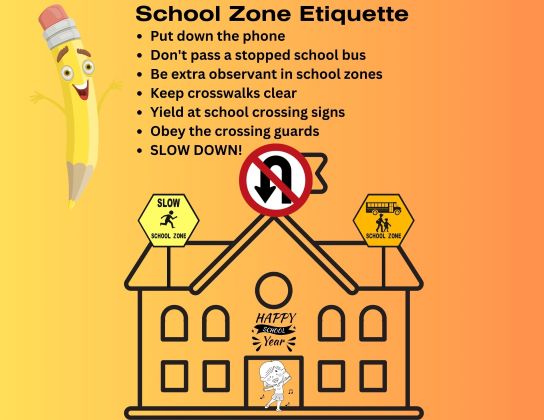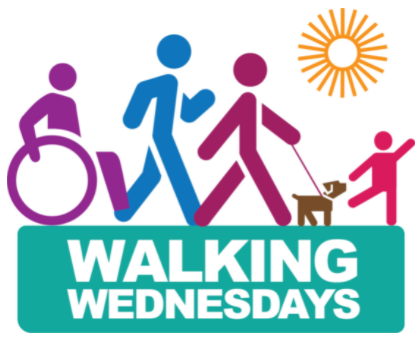Safe Routes to School (SRTS)
Helping students get physically active while taking cars off the road.
Bike and Roll to School Day
Join us on Wednesday, May 8, 2024, for Bike & Roll to School Day! Register your event at the walkbiketoschool.org website. Your event can be big or small, and giveaways will be provided (while supplies last). For help in getting started, please reach out to us at [email protected].
Sign your school up today!

- Visit walkbiketoschool.org for ideas on how to plan your event
- How to plan an event in 7 days
- Promote your event with these downloadable materials
About Safe Routes To Schools
Safe Routes to School (SRTS) programs help students get physically active while taking cars off the road. Over the past four decades:
- The percentage of students who walk and bicycle to school has declined from 48 percent (1969) to 13 percent (2009).
- The percentage of parents using Kiss and Ride has increased.
- Traffic conditions around many schools has gotten worse making it more difficult for student walkers and bicyclists to get to school.
Originally a federally funded program, SRTS is now in schools in every state. Safe Routes to School can:
- Educate students on pedestrian and bicycle safety.
- Help students reach the recommended 60 minutes of daily physical activity.
- Help students arrive at school energized and ready to learn.
- Reduce traffic around schools.
- Improve air quality around schools.

About 30 percent of our elementary and middle schools take part in SRTS programs. The goals in FCPS are:
- To increase the number of schools participating.
- To increase the number of students who take part in safe walking and biking activities.

Walking Wednesdays
Walking Wednesdays are a county-wide initiative in partnership with the Fairfax County Park Authority’s Move Your Way and Healthy Strides campaigns. Inova Fairfax and the Partnership for a Healthier Fairfax also support the campaign.
Transportation Options
When safe and possible, have your student use active transportation to school, walking, biking, or scootering. Active transportation has many benefits for our students:
- Exercise and fresh air every day for the walkers.
- Get rid of extra energy for better concentration in class.V
- Get to know your neighborhood and feel safe in it.
- Builds your student’s independence and confidence.
- Fewer students being dropped off = fewer cars at school = a safer school zone! • Fewer cars = less pollution and greenhouse gas emissions.
- Walking is free! Driving a vehicle costs money (gas, maintenance)
Kiss and Ride drop-offs have been overwhelmed with cars because of the bus driver shortage. Please consider parking away from school and walking with your student the rest of the way. This way you and your student get in a little exercise. If there is a public parking lot near the school, think about working with your neighbors and start a walking school bus from a remote location.
Does your student know the pedestrian rules for crossing the street? Here is a video made by the students at McNair Upper Elementary.
FCPS Bicycling to School
Allowing students to bicycle to school promotes physical fitness and helps the student develop a sense of independence. It is the parent’s decision as to when their child is ready to bike to school. Parents may want to follow these guidelines when determining if their child is capable of biking to school:
- Student age, maturity, and physical condition
- Is the route to school along quiet streets?
- Does the school have a bike rack to secure the bicycle and the student has a lock?
- Have you practiced the route to school with your child?
- If your child is more comfortable riding on the sidewalk, remember to yield to pedestrians and give an audible signal when approaching and passing a pedestrian.
- Does your student understand and follow the rules of the road? Stopping at stop signs, riding with traffic, obeying crossing guards, and yielding to pedestrians.
- Students under the age of 15 are required to wear a helmet by Fairfax County law.
- Students should wear bright or reflective clothing.
- Be alert, be predictable, and pay attention to your surroundings.
- As the student approaches their school and encounters more pedestrians, the student should dismount and walk their bike to the bike rack.
- Consider starting a neighborhood bike train to school. Safety in numbers.
Students should not have to complete a permission slip to bike to school. Bicycle safety rodeos can be offered to school communities to ensure students learn bicycle safety skills. Contact the Safe Routes to School coordinator.
The video below of Marshall Road Elementary School students shows a bike train, or some call it a bike bus. It is a great way for kids to get to and from school. It provides students an opportunity to work on their physical, mental, and emotional health. It also reduces the number of cars on the ride and reduces emissions around schools. For help in getting started, please reach out to us at [email protected].
Student Travel Tallies and Parent Surveys
Each fall schools survey their students about their travel to and from school. Collecting tallies on an annual basis is a great way to track the impact of your SRTS program.
A Student Travel Tally is a quick, in-class survey that provides valuable information on how students get to school. For more information on how to conduct a Student Travel Tally or a Parent Survey contact the FCPS Safe Routes to Schools Coordinator.
Community Champions
Community champions are parents or teachers who lead the effort to get more students to walk or bike to school. This can be informal or a formal position in the PTA/PTO. The champion helps to organize Walk to School Day or Bike to School Day events. They can also promote weekly or monthly walking/biking programs. Are you your community’s champion for Safe Routes to School?
Middle School Safe Routes to School video contest winner!